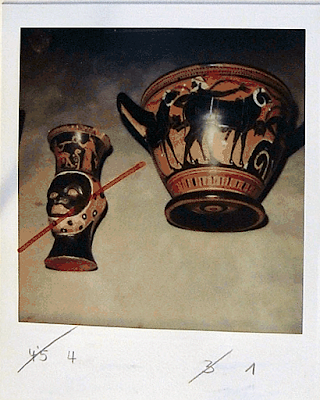 |
| Source: Manhattan DA (September 6, 2022) / Lynda Albertson (on Twitter) |
21 classical antiquities have been
returned to Italy following their seizure from New York's Metropolitan Museum of Art. LM has listed some of the
key people associated with the material.
The objects appear to include (though no definitive list seems to have been issued by the museum):
Sculpture
b. A marble head of Athena. Inv. 1996.178.
e. Marble head of a horned youth wearing a diadem. Inv. 2012.479.10. The work has been on loan to, and on display at, The Metropolitan Museum of Art since 2007.
q. A marble head of a bearded man. Inv. 1993.342.
t. Castor and Pollux.
Silver Plate
f. Gilded silver phiale. Inv. 1994.57.
Gold
l. Pair of gold Apulian cylinders. Inv. 1981.134.1, .2
Bronzes
a. A bronze plate. Inv. 1986.322.2.
s. Bronze statuette of Jupiter. Inv. 1997.159. 1987-1997, on loan to the San Antonio Museum of Art, Texas.
Armour
m. Bronze helmet of Corinthian type. Inv. 2003.407.3.
n. Bronze helmet of Italian -Corinthian type. Inv. 2003.407.5.
o. Bronze helmet of Apulian-Corinthian helmet. Inv. 2003.407.4.
Athenian Pottery
Black-figured
c. Attic bf neck-amphora, attributed to the Princeton painter. Inv. 1991.11.2.
h. Attic bf lekythos, attributed to the manner of Elbows Out. Inv. 1985.11.3
j. Attic bf amphora fragment, attributed to Lydos. Inv. 1985.11.1.
k. Attic bf amphora fragment, attributed to the Amasis painter. Inv. 1985.11.2.
u. Attic bf amphora fragment, attributed to the Amasis painter. Inv. 1985.53.
White Ground
p. Attic wg cup, attributed to the Villa Giulia painter. Inv. 1979.11.15.
Red-figured
d. Attic rf cup, signed by Hieron and attributed to Makron. Inv. 1979.11.8, 1988.11.4, 1990.170.
Terracottas
r. Terracotta statuette of a draped goddess. Inv. 2000.163. Gift of Robin Symes, in memory of Christo Michailidis, 2000.
Glass
g. A glass situla with silver handles. Inv. 2000.277.
| |




















